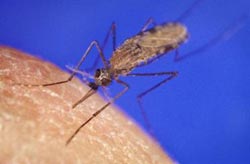Malaria parasite's masquerade ball could come to an end

Anopheles mosquito (Photo: Centers for Disease Control and Prevention) <br>
More than a million people die each year of malaria caused by different strains of the Plasmodium parasite transmitted by the Anopheles mosquito. The medical world has yet to find an effective vaccine against the deadly parasite, which mainly affects pregnant women and children under the age of five.
By figuring out how the most dangerous strain evades the watchful eye of the immune system, researchers from the Hebrew University of Jerusalem have now paved the way for the development of new approaches to cure this acute infection.
Upon entering the bloodstream, the Plasmodium parasite reproduces in the red blood cells and transports its proteins to their surface. These cells become sticky and cling to the walls of blood vessels, blocking them and damaging the human body. The immune system typically identifies these proteins as foreign and creates antibodies to fight the disease.
The deadliest of the five Plasmodium strains is Plasmodium falciparum, which causes more than 90% of deaths associated with malaria. This sophisticated strain deceives the immune system by revealing only one protein encoded by one of the sixty genes at its disposal. While the immune system is busy fighting that protein, the parasite switches to another protein not recognized by the immune system, thus avoiding the antibody response and re-establishing infection.
In research conducted at the Department of Microbiology and Molecular Genetics at the Institute for Medical Research Israel-Canada, and the Kuvin Center for the Study of Infectious and Tropical Diseases at the Hebrew University-Hadassah Medical School, Dr. Ron Dzikowski and research student Inbar Avraham revealed for the first time the genetic mechanism that enables a parasite to selectively express one protein while hiding other proteins from the immune system.
By combining bioinformatic and genetic methods, the researchers identified a unique DNA sequence found in the regulatory regions of the gene family that encode for these surface proteins. They showed that the parasite's ability to express only one gene while hiding the other 59 depends on this sequence. The research suggests that by interfering with the regulatory role of this DNA sequence it would be possible to prevent Plasmodium falciparum from hiding most of its destructive genes from the immune system.
According to Dr. Dzikowski, “These results are a major breakthrough in understanding the parasite's ability to cause damage. This understanding could lead to strategies for disrupting this ability and giving the immune system an opportunity to clear the infection and overcome the disease. This clever parasite knows how to switch masks to evade an immune attack, but our discovery could lead to new ways to prevent it from continuing this dangerous game.”
The research, “Insulator-like pairing elements regulate silencing and mutually exclusive expression in the malaria parasite Plasmodium falciparum,” was published this week in the Proceedings of the National Academy of Sciences. It was funded by the Israel Academy of Sciences and Humanities and the Einstein Kaye Fellowships, which supports outstanding research students.
For information, contact:
Dov Smith, Hebrew University Foreign Press Liaison
02-5881641 / 054-8820860 (+972-54-8820860)
dovs@savion.huji.ac.il
Orit Sulitzeanu, Hebrew University Spokesperson
02-5882910 / 054-8820016
orits@savion.huji.ac.il
Media Contact
More Information:
http://www.huji.ac.ilAll latest news from the category: Life Sciences and Chemistry
Articles and reports from the Life Sciences and chemistry area deal with applied and basic research into modern biology, chemistry and human medicine.
Valuable information can be found on a range of life sciences fields including bacteriology, biochemistry, bionics, bioinformatics, biophysics, biotechnology, genetics, geobotany, human biology, marine biology, microbiology, molecular biology, cellular biology, zoology, bioinorganic chemistry, microchemistry and environmental chemistry.
Newest articles

Silicon Carbide Innovation Alliance to drive industrial-scale semiconductor work
Known for its ability to withstand extreme environments and high voltages, silicon carbide (SiC) is a semiconducting material made up of silicon and carbon atoms arranged into crystals that is…

New SPECT/CT technique shows impressive biomarker identification
…offers increased access for prostate cancer patients. A novel SPECT/CT acquisition method can accurately detect radiopharmaceutical biodistribution in a convenient manner for prostate cancer patients, opening the door for more…

How 3D printers can give robots a soft touch
Soft skin coverings and touch sensors have emerged as a promising feature for robots that are both safer and more intuitive for human interaction, but they are expensive and difficult…





















